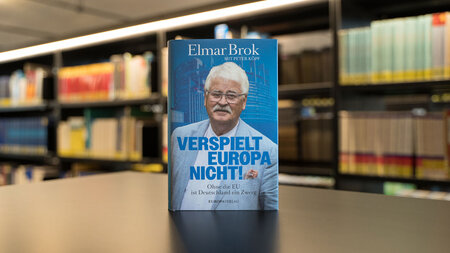World’s Smallest Microelectronic Catheter for Minimally Invasive Surgery of the Future
Research team from Chemnitz University of Technology, IFW Dresden and Max Planck Institute CBG presents a completely new type of biomedical tool with a tiny biocompatible, microelectronic micro-catheter equipped with sensor and actuator functions
 open gallery
open gallery -

New type of biomedical tool: Boris Rivkin is PhD student in Oliver G. Schmidt's research group at Chemnitz University of Technology. With his fellow researchers he developed the world's smallest microelectronic catheter equipped with sensor and actuator functions. Photo/Montage: Boris Rivikin (private)/ Chemnitz University of Technology -

Prof. Dr. Oliver G. Schmidt is a pioneer in the exploration and development of extremely small, shapeable and flexible microrobotics. The photo shows him with an ultra-flexible microelectronic foil between his fingers. Photo: Jacob Müller
Catheters are of paramount importance for minimally invasive surgery. They enable interventions such as the removal of blood clots, the insertion of implants, or the targeted administration of drugs, and are intended to be particularly gentle for patients. In general, the less invasive the catheter procedure, the lower the risk of medical complications and the shorter the recovery time.
However, there are limits. For instance, previously developed sensors and actuators were still integrated by hand into electronic catheters. In addition, control and placement of catheters in the body are limited, because the tiny instruments have to be maneuvered externally by the surgeon in a complex environment or placed with robotic assistance. This has significant disadvantages for miniaturization and the use of flexible structures that need to adapt to the body for particularly gentle use in surgery. It has also been difficult to integrate additional sensors and functions into micro-catheters, which hampers their potential applications.
Under the supervision of Prof. Dr. Oliver G. Schmidt, head of the Professorship for Material Systems for Nanoelectronics, designated Scientific Director of the Center for Materials, Architectures and Integration of Nanomembranes (MAIN) at Chemnitz University of Technology and former Director at the Leibniz Institute for Solid State and Materials Research (IFW Dresden), scientists at IFW Dresden in cooperation with the Max Planck Institute for Molecular Cell Biology and Genetics (CBG) have now presented the world's tiniest flexible, microelectronic microcatheter.
Smart functions – as thin as a hair: New type of biomedical tool
In this smart microelectronic tool for minimally invasive surgery, the electronic components for sensors and actuators are already integrated into the catheter wall from the outset. "Due to the special manufacturing method, the embedded electronic components have no effect on the size of our catheters, which can thus be as thin as a single hair", says Boris Rivkin, lead author of the study, who is pursuing his doctoral graduation at Chemnitz University of Technology and his dissertation at Leibniz IFW Dresden. The instruments have a tiny diameter of only 0.1 mm and are also characterized by their flexibility, resilience, and high biocompatibility. "Using microchip technologies to manufacture the microcatheters allows us to generate completely new types of biomedical and multifunctional tools," adds Prof. Schmidt. Such smart tools could be used, for example, in minimally invasive treatments of aneurysms, vascular malformations, or pancreatic surgery.
The research team reports on the World’s smallest Microelectronic Catheter in a publication entitled "Electronically integrated microcatheters based on self-assembling polymer films" in the current issue of the prestigious journal Science Advances.
Flexible and equipped for diverse applications: New applications for minimally invasive surgery
Prof. Schmidt and his team integrated magnetic sensors for navigation and positioning into the micro-catheter. Like a compass, this tracking relies on weak magnetic fields instead of harmful radiation or contrast agents, and would thus be applicable in deep tissue and under dense materials such as skull bones.
The microelectronic microcatheter integrates a channel for fluids. Through this microfluidic system drugs or liquid embolic agents could be delivered directly to the point of use. The catheter tip is equipped with a tiny gripping instrument that allows the catheter to grasp and move microscopic objects. The removal of minute tissue samples or blood clots are suggested as potential applications. This highly flexible use of embedded microelectronics is made possible by integrated electronic components based on the Swiss-Roll Origami Technology. By this technology the team can construct highly complex microelectronic sensor and actuator circuits on a chip, which are then triggered to roll up by themselves into a Swiss-Roll microtube structure. The multiple windings of the Swiss-Roll architecture significantly increase the usable surface area and monolithically integrate sensors, actuators and microelectronics into the compact wall of the tubular microcatheter.
Prof. Schmidt and his team have pioneered this technology for some time. Extremely thin, shapeable polymer films have proven useful for a microtube architecture that can geometrically adapt to other objects, for example, cuff implants as bioneural interfaces. Another application scenario targeted by this technology are catalytic micromotors and platforms for electronic components to create microelectronic swimming robots.
The microelectronic microcatheter bridges the gap between electronically enhanced instruments and the size requirements of vascular interventions in submillimeter anatomies. In the future, additional sensor functions can be integrated, expanding the range of potential applications. For example, sensors for blood gas analysis, biomolecule detection, and sensing physiological parameters such as pH, temperature, and blood pressure are conceivable. Entirely new and flexible applications for minimally invasive surgery are coming into the realm of possibilities.
About team leader Prof. Dr. Oliver G. Schmidt
Oliver G. Schmidt is Professor for Material Systems for Nanoelectronics at Chemnitz University of Technology since 2007 and was Director of the Institute for Integrative Nanoscience at the Leibniz Institute for Solid State and Materials Research (IFW) Dresden from 2007-2021. He initiated and is the designated Scientific Director of the Center for Materials, Architectures and Integration of Nanomembranes (MAIN) at Chemnitz University of Technology. Schmidt is a pioneer in the field of microrobotics and micromotors. He and his research team's work in nanoscience is positioned at the interface of physics, chemistry, materials science, electronics and microsystems engineering. Schmidt has demonstrated the application potential of his scientific findings in microrobotics, photonics, sensor technology, medicine, and energy storage in numerous research papers. In 2010, he and his then-colleagues built the smallest man-made jet propulsion system and in 2020 the smallest microelectronic robot. In 2018, he was honored with the Gottfried Wilhelm Leibniz Prize – the most important research funding award in Germany – for his outstanding work on the research, production and innovative application of functional nanostructures. Schmidt is a member of the Saxon Academy of Sciences as well as the German Academy of Science and Engineering (acatech).
Publication: Boris Rivkin et al. Electronically integrated microcatheters based on self-assembling polymer films. Science Advances 7, eabl5408 (2021). DOI: 0.1126/sciadv.abl5408
For additional information, please contact Prof. Dr. Oliver G. Schmidt, head of the Professorship for Materials Systems for Nanoelectronics at Chemnitz University of Technology, E-mail oliver.schmidt@main.tu-chemnitz.de.
(Author: Matthias Fejes / Translation: Chelsea Burris)
Matthias Fejes
22.12.2021





